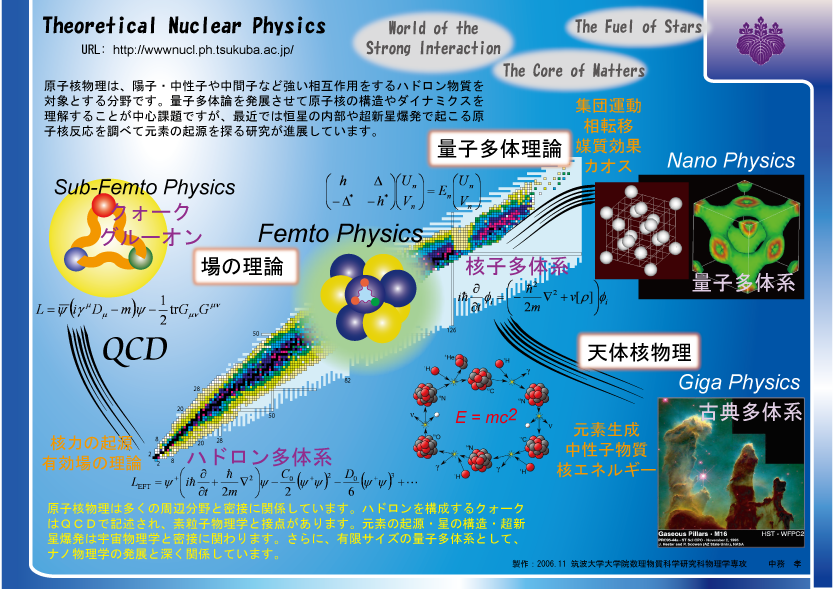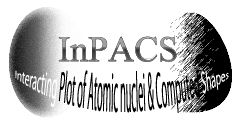新着情報
- 2025/12/08
- 新メンバー:Liさん New member: Li
- 2025/11/04
- Seminar (セミナー)2025.11.7 Gubler, Philipp (JAEA)
- 2025/11/01
- 新メンバー:Gublerさん New member: Gubler
- 2025/09/08
- Ishikuro-san received Encouragement Award at TIA NanoGreen Summer School; 石黒さん第13回TIAナノグリーン・サマースクール奨励賞受賞
- 2025/08/01
- Shoji-san received Presentation Award at Particle Physics Computing Consortium Summer School (PPCC-SS-2025) 庄司さん第8回粒子物理コンピューティングサマースクール優秀発表賞受賞
- 2025/07/08
- ハイライト論文に選定 A paper selected as Editors’ Suggestion
- 2025/05/01
- 新メンバー:角田さん New member: Tsunoda
- 2025/04/05
- 新メンバー:赤井さん、石黒さん、千葉さん、石井さん、内野さん、時長さん New members: Akai, Ishikuro, Chiba, Ishii, Uchino, and Tokinaga

当グループは、原子核物理学はもとより物理科学や光科学など幅広い分野で理論研究を展開しています。
In our group, we perform researches in wide fields of theoretical physics, not only nuclear physics, but also material and optical science.
原子核の構造と反応
原子核は、数個から数百個の核子(陽子と中性子)が強い相互作用により束縛した量子系です。液滴のようなマクロな性質と、有限サイズの量子多体系としてのミクロな性質を併せ持つユニークな物質です。核子の自由度で記述されたハミルトニアンから出発して、原子核のさまざまな性質を「ミクロ」(核子の自由度から量子論的)に理解することが大きな目標です。
最近の原子核物理学の大きな流れの一つに、元素の起源を探る研究があります。現在太陽系に存在する原子核は、過去の宇宙規模のイベントー宇宙初期のビッグバン・星の内部での核融合反応・星の終末期に起こる超新星爆発など-で生成されたものです。原子核がどのように生成されたかを知り、宇宙の成り立ちを理解するためには、自然界には存在しない不安定原子核の構造や反応を探り、宇宙で起こる原子核反応を理論と計算により解明することが必要です。
Nuclear structure and reaction
Nucleus is a quantum system binding a few to hundreds of nucleons (protons and neutrons) with the strong interaction. Nucleus is a unique matter which exhibits macroscopic properties like a liquid drop as well as microscopic properties in quantum many-body systems of finite size. One of big challenges for us is to understand various nuclear properies based on the microscopic quantum mechanics, starting from a Hamiltonian given in terms of nucleons' degrees of freedom.
One of recent trends in nuclear physics is to investigate origins of elements. Nuclei currently present in our solar system were produced in the Big Bang in early universe, fusion reaction in stars, supernovae at the terminal stage of stars, etc. In order to understand how nuclei were produced and how the universe were made, it is necessary to understand nuclear reaction rates in the universe, by investigating structure and reaction of unstable nuclei that are not present in nature.
物質科学・光科学と電子ダイナミクス
原子核を構成する陽子と中性子、そして原子・分子・固体などの物質世界を構成する電子は、ともに凝縮状態にあるフェルミ粒子です。私たちの研究室では、これらの物質を構成するフェルミ粒子系に対して共通の理論や方法を用いて研究を進めています。
物質科学の広範な世界で私たちが注目しているのは、光と物質の相互作用で引き起こされる電子の量子ダイナミクスです。レーザー技術をはじめとする発展により、今日の光科学のフロンティアでは物質中の電子の運動をフェムト秒からアト秒という極限の時間スケールで測定し制御する研究が進んでいます。計算機を用いて時間依存シュレディンガー方程式を解くことにより、これらのミクロな空間で起こる非常に短い時間スケールの現象を解明することができます。
Material science and electron dynamics
Protons and neutrons in nuclei, as well as electrons in atoms/molecules/solids, are degenerate fermions. Our group is pursuing researches on these fermion many-body systems using common theories and methods.
We are interested in electrons' quantum dynamics induced by the interaction between light and materials. Due to significant advances in laser technology, in the frontier research of optical science, researchers are able to detect and control electronic motion in materials at the time scale of femto to atto second. Solving the time-dependent Schroedinger equation using computers, we are aiming at understanding phenomen in the microscopic space at very short time scales.
本研究室で研究を希望される方へ
本研究室で一緒に研究することを希望される方を募集しています。筑波大学大学院数理物質科学研究科物理学専攻の入試に関する関連リンクの研究科もしくは専攻のページをご覧ください。毎年5月に大学院説明会がありますが、それ以外の機会でも随時研究室訪問を受け付けています。
We welcome graduate students who wish to perform researches with us. Please take a look at pages of Faculty of Pure and Applied Sciences and/or Department of Physics, University of Tsukuba (in the link at the left). There, you will find information about the admission examination. In addition to an event of open campus in May, we welcome your visit to our group in any occasion.


